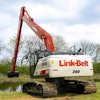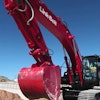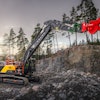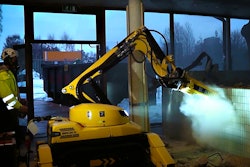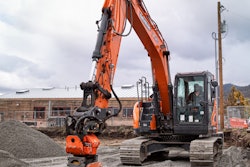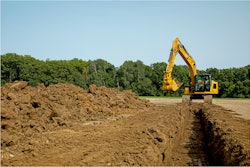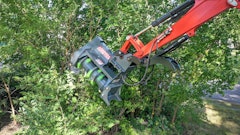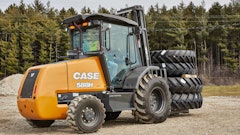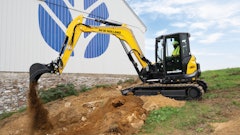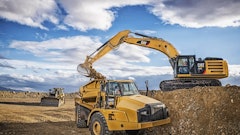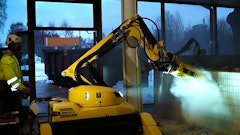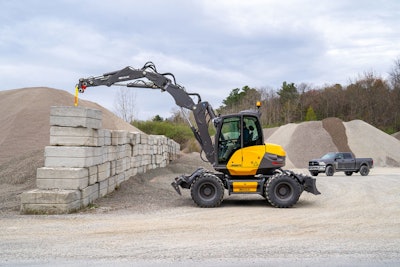
As the old saying goes, necessity is the mother of invention. These days, there is no shortage of necessity for new ways of doing construction work given the ongoing labor shortages, safety hazards, and confined jobsites that require a more compact equipment footprint. While these are just a few of the vital factors on many contractors’ minds today, true innovation for construction work does not just respond to the necessities of a jobsite but reimagines it. Cue compact wheeled excavators.
Organizing a jobsite can be a complicated logic puzzle, and it is tempting to fall back on the old standbys. However, this approach risks missing opportunities that address industry challenges and revolutionize operations. For instance, a single piece of construction equipment that can perform the applications of multiple machines while reducing labor costs and boosting safety may seem too good to be true. However, wheeled excavators make this dream a reality and are providing daily benefits to contractors today.
Speedy On-Site
One of the benefits of a compact wheeled excavator is its ability to travel — up to 25 mph for some advanced models — whether that is zipping across a jobsite or traveling from site to site. Not all equipment can match that speed. With a tracked excavator and compact track loader, operators must take the time to load each machine on a trailer, haul them to the next site and unload the machines before they can begin operating again. One wheeled excavator, on the other hand, can replace the excavator and compact track loader. It can also travel much faster and traverse two miles in just five minutes — saving time loading and hauling. That increase in speed quickly adds up in terms of job timelines, billable hours, and overall efficiency.
Obstacles such as trees or power lines on the jobsite can also impede the speed of machines that do not have a specialized design to navigate around them. Nino Foti, a contractor in New York, experienced the benefits of a compact excavator’s maneuverability while replacing valves, trenching, and laying pipes. Whereas typical tracked excavators on the site spent extra time steering around power lines that stymied their standard booms, Foti could tuck in the three-part boom of his machine to drive under them. Because he could go directly where he needed to dig quickly, he noted that his wheeled excavator performed 30% faster than any other piece of equipment on the site.
All-in-One Compact Package
In an ideal world, every machine would be running and earning money 100% of the time. However, this target is rarely realized as owner-operators typically see 30% to 35% efficiency out of any one unit on site. When operators can replace multiple machines with a wheeled excavator, though, the 100% efficiency goal becomes much more attainable. 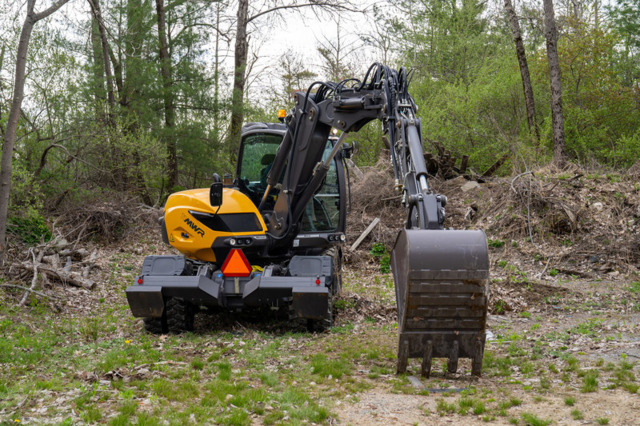 Mecalac
Mecalac
The key is finding a design that is truly multipurpose without sacrificing performance. Compact excavators equipped with a hydraulic quick coupler can make quick transitions between attachments such as buckets or forks, which turn the machines into telehandlers/rough terrain forklifts. Only this can unload pallets below grade.
Then consider the benefits of a machine that has four-wheel steering, allowing an incredibly tight turn radius, paired with the power and range to lift three tons up to 10 feet with a 360-degree rotation. This is a machine that can park in a single space if needed, and with its uniquely designed boom work outside the width of the machine, maintains perfect stability.
The combination of speed plus multi-functionality and maneuverability translates to increased jobsite productivity with reduced costs. Foti explained that he can switch between attachments in less time than it takes for an operator to navigate a backhoe to use either its front loader or bucket for the same task. This means that while a five-person crew usually installs an average of 10-12 pipes in a nine-hour shift, his four-person crew, using a compact wheeled excavator, averages 13 to 14 pipes in seven hours. To put it another way, if those two crews were working nine hours and seven hours, respectively, each day for a five-day work week, the crew placing 12 pipes a day would complete 60 pipes in 45 hours. The seven-hour crew would work 10 fewer hours but place 10 more pipes in that time.
(Wheels &) Boots on the Ground
Safety is of utmost importance. With some wheeled excavators, prioritizing safety may mean sacrificing productivity. One designed to address safety and productivity should have a low, consistent center of gravity. This offers stability, even when driving the machine on slopes or down inclines. Some designs feature the capability to carry loads safely in these situations and are designed in a way that even with the low center of gravity, the ground clearance remains high enough to maneuver over a variety of uneven terrain. Older, top-heavy designs with higher centers of gravity and too much weight in the front do not lend themselves as well to off-road operations.
Another design feature to consider is operator accessibility to the cab and fuel tank. Wheeled excavators that allow operators to fill the tank from ground level without stepping on the tire of the machine eliminate the risk of a preventable accident. Additionally, when operators can access the fuel tank, grease points, and filters from the ground, regular maintenance can be performed quickly and safely.
Breaking the Mold
The multi-functionality of a wheeled excavator can shake up traditional methods of organizing a jobsite, but that’s a good thing. A compact piece of equipment doing the work of several machines helps contractors maximize productivity while cutting expenses on machinery and reducing labor costs. Construction operations that seize the opportunity wheeled excavators offer can not only address current jobsite headaches but also lead the way in redefining how jobsite tasks are completed to yield higher profitability.
